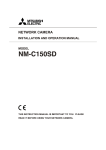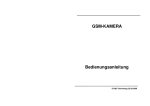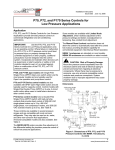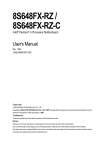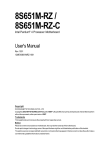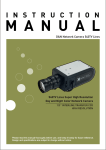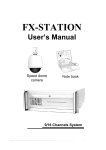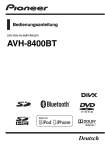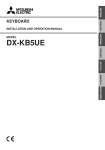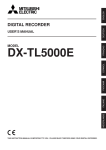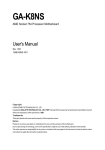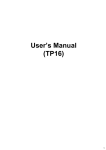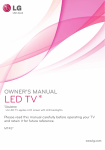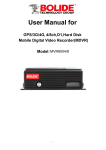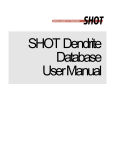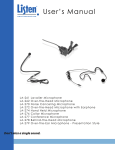Download User Manual
Transcript
This unit complies with the requirements of the EC Directive 2004/108/EC, “EMC Directive”. The requirements for the susceptibility according to EN 55024 and the requirements for interference according to EN 55022 are observed for the operation on residential areas, business, light industrial premises and in small scale enterprises, inside as well as outside of the building. All places of operation are characterized by their connection to the public low voltage power supply system. Warning This is class A product. In a domestic environment this product may cause radio Interference in which case the user may be required to take adequate measures. i Note: This symbol mark is for EU countries only. This symbol mark is according to the directive 2002/96/EC Article 10 Information for users and Annex IV, and/or to the directive 2006/66/EC Article 20 Information for end-users and Annex II. Your MITSUBISHI ELECTRIC product is designed and manufactured with high quality materials and components which can be recycled and/or reused. This symbol means that electrical and electronic equipment, batteries and accumulators, at their end-of life, should be disposed of separately from your household waste. If a chemical symbol is printed beneath the symbol show above, this chemical symbol means that the battery or accumulator contains a heavy metal at a certain concentration. This will be indicated as follows: Hg: mercury (0.0005%), Cd: cadmium (0.002%), Pb: lead (0.004%) In the European Union there are separate collection systems for used electrical and electronic products, batteries and accumulators. Please, dispose of this equipment, batteries and accumulators correctly at your local community waste collection/recycling centre. Please, help us to conserve the environment we live in! ii IMPORTANT SAFEGUARDS 1. READ INSTRUCTIONS -- All the safety and operating instructions should be read before the appliance is operated. 2. RETAIN INSTRUCTIONS -- The safety and operating instructions should be retained for future reference. 3. CLEANING -- Unplug video monitor or equipment from the wall outlet before cleaning. Do not use liquid cleaners or aerosol cleaners. Use a damp cloth for cleaning. 4. ATTACHMENTS -- Do not use attachments not recommended by the video monitor or equipment manufacturer as they may result in the risk of fire, electric shock or injury to persons. 5. WATER AND MOISTURE -- Do not use video monitor or equipment near water - for example, near a bathtub, washbowl, kitchen sink, laundry tub, in a wet basement, or near a swimming pool or the like. 6. ACCESSORIES -- Do not place video monitor or equipment on an unstable cart, stand or table. The video monitor or equipment may fall causing serious injury to a child or adult and serious damage to the equipment. Wall or shelf mounting should follow the manufacturer's instructions and should use a mounting kit approved by the manufacturer. 6A. Video monitor or equipment and cart combinations should be moved with care. Quick stops, excessive force and uneven surfaces may cause the equipment and cart combination to overturn. 7. VENTILATION -- Slots and openings in the cabinet at the back or bottom are provided for ventilation and to ensure reliable operation of the video monitor or equipment and to protect it from overheating. These openings must not be blocked or covered. The openings should never be blocked by placing the video monitor or equipment on a bed, sofa, rug, or other similar surface. Video monitor or equipment should never be placed near or over a radiator or heat register. Video monitor or equipment should not be placed in a built-in installation such as a bookcase unless proper ventilation is provided. 8. POWER SOURCES -- Video monitor or equipment should be operated only from the type of power source indicated on the marking label. If you are not sure of the type of power supplied to your home, consult your video monitor or equipment dealer or local power company. For video monitor or equipment designed to operate from battery power refer to the operating instructions. 9. GROUNDING OR POLARIZATION -- This video monitor may be equipped with a polarized alternating - current line plug (a plug having one blade wider than the other). This plug will fit into the power outlet only one way. This is a safety feature. If you are unable to insert the plug fully into the outlet, try reversing the plug. If the plug should still fail to fit, contact your electrician to replace your obsolete outlet. Do not defeat the safety purpose of the polarized plug. Alternate Warnings - This video monitor is equipped with a three-wire grounding-type plug, a plug having a third (grounding) pin. This plug will only fit into a grounding-type power outlet. This is a safety feature. If you are unable to insert the plug into the outlet, contact your electrician to replace your obsolete outlet. Do not defeat the safety purpose of the grounding-type plug. 10. POWER CORDS -- Do not allow anything to rest on the power cord. Do not locate video monitor or equipment where the cord will be abused by persons walking on it. 11. HEED WARNINGS -- Follow all instructions marked on the video monitor or equipment. 12. LIGHTNING -- For added protection for video monitor or equipment during a lightning storm, or when it is left unattended and unused for long periods of time, unplug it from the wall outlet and disconnect the antenna or cable system. This will prevent damage to the video product due to lightning and power-line surges. 13. OVERLOADING --Do not overload wall outlets and extension cords as this can result in a risk of fire or electric shock. 14. OBJECT AND LIQUID ENTRY -- Never push objects of any kind into video monitor or equipment through openings as they may touch dangerous voltage points or short-out parts that could result in a fire or electric shock. Never spill liquid of any kind on the product. iii 15. SERVICING -- Do not attempt to service video monitor or equipment yourself as opening or removing covers may expose you to dangerous voltage or other hazards. Refer all servicing to qualified service personnel. 16. DAMAGE REQUIRING SERVICE -- Unplug video monitor or equipment from the wall outlet and refer servicing to qualified service personnel under the following conditions: A. When the power-supply cord or the plug has been damaged. B. If liquid has spilled or objects have fallen into the video product. C. If the video product has been exposed to rain or water. D. If the video product does not operate normally by following the operating instructions, adjust only those controls that are covered by the operating instructions as an improper adjustment of other controls may result in damage and will often require extensive work by a qualified technician to restore the video product to its normal operation. E. If the video product has been dropped, or the cabinet damaged. F. When the video product exhibits a distinct change in performance -- this indicates a need for service. 17. REPLACEMENT PARTS -- When replacement parts are required, be sure the service technician has used replacement parts specified by the manufacturer or that have the same characteristics as the original part. Unauthorized substitutions may result in fire, electric shock or other hazards. 18. SAFETY CHECK -- Upon completion of any service or repairs to this video product, ask the service technician to perform safety checks to determine that the video product is in proper operating condition. 19. FIELD INSTALLATION -- This installation should be made by a qualified service person and should conform to all local codes. 20. Don’t remove the outer covering of this unit. iv TABLE OF CONTENTS 1. Production Introduction ………………………………………… 1 1.1 Components ……………………………………………………………………………………… 1.2 VIDEO SERVER'S External View and Port Description …………………………………… 1.2.1 Front View …………………………………………………………………………………… 1.2.2 Back View …………………………………………………………………………………… 1.2.3 Side View …………………………………………………………………………………… 1.2.4 Top View …………………………………………………………………………………… 1 1 1 2 2 2 2. VIDEO SERVER Installation …………………………………… 3 2.1 Installation Order ………………………………………………………………………………… 3 2.2 Network Connection …………………………………………………………………………… 3 2.2.1 VIDEO SERVER IP Assignment ………………………………………………………… 3 2.3 Analog Camera Connection …………………………………………………………………… 4 2.4 Analog Monitor Connection …………………………………………………………………… 4 2.5 Audio Connection ……………………………………………………………………………… 4 2.6 Alarm Connection ……………………………………………………………………………… 5 2.7 RS-485 Connection ……………………………………………………………………………… 5 2.8 Power Connection ……………………………………………………………………………… 5 2.9 VIDEO SERVER Fixation ……………………………………………………………………… 5 3. Operation by Web Browser ……………………………………… 6 3.1 Accessing the VIDEO SERVER by Web Browser …………………………………………… 6 3.2 Real-Time Monitoring …………………………………………………………………………… 6 3.3 VIDEO SERVER Setting ……………………………………………………………………… 8 3.3.1 Video Setting ……………………………………………………………………………… 8 3.3.2 Live View Setting ………………………………………………………………………… 11 3.3.3 Audio Setting ……………………………………………………………………………… 13 3.3.4 Alarm Setting ……………………………………………………………………………… 14 3.3.5 PTZ Setting ……………………………………………………………………………… 18 3.3.6 System Setting …………………………………………………………………………… 22 3.4 Help ……………………………………………………………………………………………… 31 4. Appendix …………………………………………………………… 32 4.1 Troubleshooting ……………….……………………………………………………………..… 32 4.2 Preventive Maintenance …………………………………………………………………..… 32 4.3 Product Specifications ……………………………………………………………………..… 33 v 1. Product Introduction The 4-channel Video Server supports the network service for up to four existing analog cameras. An analog image entered can be monitored on a real-time screen regardless of distances and locations. By using its dedicated program, many users are able to have an access to the Video Server at once or a single user can monitor various Video Servers at the same time. It also enables users to play, store and retrieve a monitoring image by using a PC. All the settings and real-time monitoring screens are also provided through an access to the web. 1.1 Components 1.2 VIDEO SERVER’S External View and Port Description 1.2.1 Front View -1- 1.2.2 Back View Power Indicator 1.2.3 Side View Analog Camera Input BNC Connector Analog Camera Output BNC Connector 1.2.4 Top View -2- 2. VIDEO SERVER Installation 2.1 Installation Order For the operation of the Video Server, it is necessary to connect a network cable to power, and connect a general analog camera. Depending on operation methods, it is possible to connect an alarm cable or audio cable additionally. For its fixation on different locations, please consult with an installer. 2.2 Network Connection The Video Server supports the operation through the network. Therefore, it is necessary to connect a standard RJ-45 cable to it. Generally a cross cable is used for directly connection to PC, while a direct cable is used for connection to a hub. 2.2.1 VIDEO SERVER IP Assignment Video server that is first connected to network basically has no IP address. So, it is necessary to allocate the IP address of video server with an IP allocation program. Open the program folder installed with the provided CD and execute “IP Setting Utility”. 1. MAC Address - Enter MAC address of the product for IP input. 2. IP Address - Enter IP address to use. 3. Ethernet Adapter - In case there are several network cards, select a card to use for the operation of video server. 4. Start - Allocate input IP to the video server to use. When a completion 5 Status message appears on ○ window in several seconds or minutes, input completes its process. You can add additional IPs to other devices continuously. -3- 2.3 Analog Camera Connection Connect the analog camera to the video input of the Video Server. Connect a general camera of PAL/NTSC type. Users can enter up to four analog cameras and check input image on a display device. For more information on analog camera installation and BNC input display, consult with an installer. 2.4 Analog Monitor Connection Connect an analog monitor to the image output terminal of video server. For more detailed information about the installation of analog monitor which can accept BNC input, please ask an installation provider. 2.5 Audio Connection The Video Server enable voice transceiving through the audio input/output module interworked. Use it after connecting the port to the microphone and speaker, which have an amplifier function. External Micrphone External Speaker -4- 2.6 Alarm Connection Users can control the alarm systems like a siren, an alarm and a warning light through two alarm inputs. For technical support necessary to use the alarm function, please contact the installer. 2.7 RS-485 Connection The four RS-485 terminals are provided to control the four RTZ cameras. 2.8 Power Connection The Video Server requires a stable power supply for normal operation. It uses an adapter of the DC 5V / 4A specifications. It is recommended to use with an uninterruptible power supply (UPS). 2.9 VIDEO SERVER Fixation For the general installation of the Video Server, users can fix the Video Server to the wall or control box with the screw holes on the both sides of the main frame by using the screws included in the product. Besides this installation method, there are various ones which slightly differ depending on locations and operation methods. So, please consult with an installer. -5- 3. Operation by Web Browser 3.1 Connecting the VIDEO SERVER by Web Browser ●Execute the Web Browser on the PC. ●Enter the Video Server address on the address window of the Web Brower and execute it. Ex) http://192.168.0.2/ (If the Video Server has no IP address or its IP address is wrong, users will fail to connect the Video Server. In this case, users will have to connect the Video Server by the Web Browser after entering the IP address with the IP Setting Utility.) ●Refer to ‘2.2.1 Video Server IP Assignment’ section for detailed information. ●If a security window for the ActiveX Controller installation appears, press the Confirm and install it. ●If it is not connected in the Internet, from the CD-ROM install the ActiveX Controller by manual operation. 3.2 Real-Time Monitoring Supports 4 individual channel and Quad screen, and an automatic conversion screen, along with 4 types of screen size each. Gives support to 4 types of screen size covering D1, VGA, CIF, and QCIF, among which users can select and monitor the most reasonable size. Please, adjust the mode in accordance with your PC specifications and monitoring purposes. -6- If you move a screen mode to “Quad”, you can watch the 4 input cameras on a single screen. When you set a screen mode to “Sequence”, a total of 5 screens including 4 respective channel and Quad screen present their automatic conversion as the designated settings by users. For more concrete setting method, please see “3.3.2 Live View Setting – Sequence Mode”. In case of real-time monitoring with the Web Browser, one Video Server will be connected to just one Web Browser. However, this case is not suitable for monitoring various screens at the same time. If users are to monitor various images at the same time, please contact your dealer. □HTTP tunnel mode When the screen is not indicated, check. (Notice: "unicast mode" only it is applied.) If users are to control the volume of a microphone and speaker connected to a user PC, they should adjust the user PC volume regardless of the microphone and speaker volume control set in Video Servers. -7- 3.3 VIDEO SERVER Setting Video Server setting is divided into video, audio, alarm, and system settings. And the detailed screen will be provided for each setting. 3.3.1 Video Setting For image settings, there is 4 division: Channel1, Channel2, Channel3, Channel4, Quad, and Sequence. Each channel menu contains an image for real-time monitoring and a menu on network transport, and with this setting alone all the necessary settings for watching monitoring screens can be completed. z Channel Setting Setting method from Channel1 to Channel 4 is the same. Image Appearance Resolution It enables users to determine a basic screen size when having an access through the Web Browser or PC program. The screen size control comes in four modes like D1, VGA, CIF, and QCIF. Users can reset the selected screen size anytime while monitoring the screen on a real-time basis. Compression When it is necessary to adjust a smooth transmission status according to network situations, users can increase the compressibility to carry out the network transmission stably. On the other hand, when it is necessary to maintain a detailed monitoring screen by enhancing the image quality, users can do so by decreasing the compressibility. In ease case, please adjust this function according to the network status and monitoring purposes. The basic value is 2000(Kbps). -8- Image filter The image filter control enables users to reinforce the image quality in a strong or weak way. The basic value is "disabled.” BCSH Adjust Brightness The screen brightness can be adjusted from 0 to 255 stages, and the basic value is 128. The brightness may differ depending on the equipment and PC monitor status. Contrast The screen contrast can be adjusted from 0 to 255 stages, and the basic value is 128. The contrast may differ depending on the equipment and PC monitor status. Saturation The screen saturation can be adjusted from 0 to 255 stages, and the basic value is 128. The saturation may differ depending on the equipment and PC monitor status. Hue The screen hue can be adjusted from 0 to 255 stages, and the basic value is 128. The hue may differ depending on the equipment and PC monitor status. Text Overlay Settings Cast a reflection of characters for camera separation on a monitoring screen. Enable: Check for the use of Text Overlay function. Content: Enter characters for Text Overlay. Location: Appoint a location for character reflection. MPEG4 Video Stream Frame rate Upon the real-time play, users should select a frame refresh rate per second. If the rate is high, the image will become smooth. On the other hand, if the rate is low, the image will not be natural but it can reduce a network load. Bit-rate control -Variable bit rate (VBR): It refers to the type of using a variable bit rate (VBR). Increase a bit rate for the image with much motion, and decrease a bit rate for the image with little motion. The basic setting value is a VBR type. -Constant bit rate (CBR): Using a constant bit rate (CBR) may guarantee a stable play. However, if a large amount of data is not required, it may cause the waste of a transmission rate. If a large amount of data is required, it may cause the image quality to be decreased. Profile SP (Simple Profile) is available up to the CIF resolution and 384kbit/s. ASP (Advanced Simple Profile) is available up to the 4CIF resolution and 8000kbit/s. GOV size Enter the GOV (group of VOP) size. If users want to have a high quality of fast image one by one, please decrease the value. For the purpose of general monitoring, please do not change a basic value. Such act may cause a problem to the system performance. For the details of GOV setting, please contact the service center. -9- z Quad Setting It is an image setting for Quad Mode which allows 4 input images to be seen on a single screen. Setting methods for Image Appearance and MPEG4 Video Stream takes the same process as the image settings of each channel. z Sequence Setting It is an image setting for Sequence Mode which shows 4 input images with an automatic sequential switching. The setting method for Image Appearance and MPEG4 Video Stream is the same as the image setting of each channel. - 10 - 3.3.2 Live View Setting z Source Setting Set the channel by web browser-based connection and the allocated channel to BNC Out. Default Live View Set the channel by web browser-based connection. You can select one among the 4: Channel1, Channel2, Channel3, Channel4, and Quad Stream. The chosen screen is seen on the control screen as a basic one. Screen modification is possible even during the control operation. BNC Out One screen out of the 4 input images and Quad Stream can be allocated by BNC Out. The allocated screen can be seen through general CRT monitor. - 11 - z Sequence Setting Automatic screen switching setting can be seen with the control screen and BNC Out, and either watching one of the two or the two at a time is possible. You can select, among the 4 channels and Quad screen, the screen that will be included in switching list, for each of which you can set delay time separately. Sequence Mode Setting Enable Allow checking at time of an automatic screen switching function in operation. Use sequence mode in Live View Make it possible to see the automatic screen switching on the control screen. Use sequence mode in BNC Allow the automatic screen switching to be seen on BNS Out screen. Use sequence mode in Live View and BNC Out Allow the automatic screen switching to be seen on the control screen and BNS Out screen. Channel1~4, Quad Stream Each of the 4 channels and Quad screen can be selected to be included on the switching list to set up the delay time. - 12 - 3.3.3 Audio Setting z Basic Setting Users can use a microphone and speaker by using the audio function. Audio Setting Compression type Users can increase a transmission rate or enhance a tone quality by selecting an audio compression mode. The PCM 16-bit implements the best tone quality, while the PCM 8-bit corresponds to that of radio sound. Sample rate If a sample rate is low, the tone quality will go down but the transmission rate will go up. If a sample rate is high, the tone quality will be better, but the transmission rate will drop. Please, adjust its rate in accordance with a network status or purposes. Audio Input Source Users can select either MIC input or LINE input, but cannot use both at once. Input Volume Users can control the input volume by adjusting the microphone volume. Audio Output Output Volume Users can control the output volume of the speaker connected to the Video Server. - 13 - 3.3.4 Alarm Setting This function enables users to conduct the alarm input/output setting and event setting. z Motion Setup Motion information is processed by splitting the screen into 64 areas. Each area can be selected by clicking with the mouse, and the selected area is highlighted. The area which uses the motion information as an event is shown in blue, while the area which does not use the information is indicated empty. Applicable to each of the 4 channels and Quad screen. Motion Detection Setting Enable Checks this item when using the motion information. -Sensitivity Sets up the sensitivity of a motion. This item has a value between 10 ~ 255. Lower value means high sensitivity so that a motion event occurs even for a slight movement. -Motion dwelling time Sets up the event duration time when a motion occurs. This item can have a value between 0 ~ 6 seconds. When an event occurs, the motion icon at upper right of the screen blinks for the specified period. -Enable down FPS Increases FPS of the video transferred through the network when a motion occurs. - 14 - z Alarm In Setting This function enables users to conduct the alarm input/output setting. Alarm IN Port 1 Setting Type Select the operation mode of the Alarm Input 1. Select either ‘N.O.(Normal Close)’ or ‘N.C.(Normal Open)’ Alarm dwelling time [0~180] Designate a running time for alarm occurrence. Select one out of 0 to 180 seconds. Alarm IN Port 2 Setting Type Select the operation mode of the Alarm Input 2. Select either ‘N.O.’ or ‘N.C.’ Alarm dwelling time [0~180] Designate a running time for alarm occurrence. Select one out of 0 to 180 seconds. - 15 - z Alarm Out Setting Upon the alarm occurrence, this function enables users to receive a mailing or ftp service to the mail address designated by users. SMPT(eMail) Setting From eMail address: Enter an eMail address to send a mail. Send eMail address list: Enter up to 10 eMail addresses to receive a mail. Email test: Enter an eMail address to test for sending a mail. Test button: Test for sending a mail with a value entered. FTP & JPEG Setting -FTP Settings Enable Checks to activate the FTP function. Sender IP: Enters the FTP IP address or host name to be received. Port: Enters the port number of FTP to be received. Directory: Enters the location for saving the file of FTP to be received. User: Enters the user's account when connecting to FTP. Pass: Enters the user password for connecting to FTP. - 16 - -JPEG Settings Sets up the creation condition, screen size, color and name of JPEG file to be sent to FTP. Pre event: Creates the JPEG file of chapter 1~5 for 1~2 seconds before the event is generated. Post event: Creates the JPEG file of chapter 1~15 for 1~2 seconds after the event is generated. Image size: Selects the size of JPEG file to be created among 160X120 and 320X240. Color: Selects the color or B&W of JPEG file to be created. Base Name: Write in the basic name of file to be created. Except for the basic name, It is possible to add supplementary names for discriminating multiple files. Additional suffix: Selects one among date, time and the number of sequence created. ~None: Do not add supplementary names. ~Date Time: Adds the date and time when the file was created behind the basic name. ~Sequence: Adds the number in sequence of file creation behind the basic name. z Event Setup It is possible to select and operate, from Alarm of Alarm OUT and eMail, the Motion Event occurred from each of the 4 channels & Quad screen and the Event occurred from Alarm in port 1 to 2. IN-OUT Mapping By connecting the Alarm OUT operations to the events occurred from the Alarm IN, users can send an eMail or text message. Alarm IN - Alarm IN comes in Motion, Alarm in port 1 and Alarm in port 2. Alarm OUT Alarm: Operate the equipment connected to the Alarm OUT port to the events occurred from the Alarm IN. eMail: Send an email to events occurred from the Alarm IN. FTP: Sends the captured picture to FTP by the event which occurs from Alarm input. □Enable mandatory alarm out: Enable alarm control to open/close contact. - 17 - 3.3.5 PTZ Setting z Basic Control Left or Right button: Go into the sub-menu items. Execute the command (exit). Change value. Navigate through the menu items. Up or Down button: Navigate through the menu items. - 18 - When mouse in the red area click, It moves with the direction. -PTZ PAN / TILT Speed: It sets a speed when adjusting the PTZ Camera. The higher a value is, the faster a speed will be. Focus: Overrides auto focus. Moving the Zoom handle reactivates Auto Focus mode. Iris: Overrides auto iris. Moving the joystick reactivates Auto Iris mode. Zoom: Zoom control. -OSD Zoom: Change value. Enter editing title. MENU: Enters programming menu. ESC: Cancels current inputs. Exits from currently running functions or menu, error status, etc HOME: Immediately calls Home function. Deletes selected value or function in programming mode CTRL On: Control function. Ex) CTRL + Up, Down, Right, Left Button >> Operated turbo mode. PRESET: Pressing ‘Prst’ will bring up the preset programming menu. SCAN: Pressing ‘Scan’ will bring up the Auto Scan programming menu. TOUR: Pressing ‘TOUR’ button will bring up the tour programming menu directly. PATTERN: Pressing ‘PATTERN’ button will bring up the pattern programming menu directly. - 19 - PTZ Setting -Protocol: If a PTZ Camera is to be installed with a Fastrax keyboard controller, select ‘HITRON – Fastrax II’ protocol. Consult service personnel if a PTZ Camera is installed with device other than a keyboard controller. -Device ID: Setting PTZ Camera Address (ID) Com Port Setting -Baud Rate: Setting PTZ Camera Baud Rate. (Default 9600 bps) -Data Bits: Setting PTZ Camera Data Bits. (Default None) -Parity Bits: Setting PTZ Camera Parity Bits. (Default 8 bits) -Stop Bits: Setting PTZ Camera Stop Bits. (Default 1 bit) ETC Setting -Preset: Save preset. Recall preset. -Auto Scan: Calls Auto panning function. -Tour: Recalls programmed presets or functions sequentially. -Pattern: Repeats the selected pattern of the current PTZ Camera. - 20 - It will be able to control with the keyboard. -Keyboard Short Cut Key Keyboard Key Label (PC Keyboard) Function (Fastrax Control Keyboard) ← → ↑ ↓ Shift + → Shift + ← Shift + ↑ Shift + ↓ Shift + ‘1’ Shift + ‘2’ Pan left Pan right Tilt up Tilt down Pan speed level up Pan speed level down Pan speed level up Pan speed level down PTZ mode OSD mode Focus mode - Page up (far focus) - Page down (near focus) Iris mode -Page up (open iris) -Page down (close iris) f i z Zoom mode -Page up (zoon in) -Page down (zoom out) m ESC h, HOME Ctrl r s t p MENU ESC HOME CTRL PRST SCAN TOUR PTRN - 21 - 3.3.6 System Setting z Users Setting This Video Server’s Authority Policy 1. Anonymous User Access Permit Mode This mode enables any anonymous users to have an access to the Video Server to monitor and set it. 2. Anonymous User Access Denial Mode Upon selecting this mode, the Video Server operates in two authority groups. And it also requires a log-in process when users are to have an access to the Video Server to change a screen monitoring or setting. 1) Administrator Authority Group (admin) It enables administrators to change the screen monitoring and setting of the Video Server. In addition, this authority allows only one user to have an access to the Video Server at once. 2) General User Authority Group (user) It enables users to simply use a screen monitoring function. It disables users to change the Video Server setting but allows them to have a multiple access at the same time. User setting Enable anonymous viewer login: Check it when users do not want to use the Video Server without the user account. When using the user account, users have to try login at every access. Admin Setting User name: Enter a user name for the administrator use. Password: Enter the password for the administrator use. - 22 - User List Setting Show a registered user account. - Add User Enter a user name and password to be added, and register them by pressing the “Add” button. - Modify User Information After selecting a user to be corrected and changing its name and password, press the ‘modify’ button to reflect the corrected information. - Delete User Account After selecting a user to be deleted, delete it by pressing the “Remove” button. - 23 - z Date & Time Setting Date & Time Current Time: Indicate a current time. yDate: Indicate a current day, month, and year. yTime: Indicate a current day, month, and year. New Time yTime Zone: Select a time zone to be used. Automatically adjust for daylight saving time changes: Check it if users are to apply the Summer Time. Time zone ~Synchronize with computer time: Synchronize the time with that of a current user computer. ~Synchronize with NTP server: Synchronize the time with that of the NTP server. Receive the time information from the NTP (RFC2030) server. ~Synchronize with date server: Enter the Time Server address to be synchronized. Receive the time information from the Time Server that complies with the Time protocol (RFC868). ~Set manually: Users enter a current time directly. yDate: Enter a current day, month, and year. yTime: Enter a current day, month, and year. - 24 - z Network Setting Setting in regard to network can be executed. Settings for IP, DNS, Host Name, Port, and Network traffic can be established, along with setting for DDNS and RTP. Basic Setting Basic settings for IP, DNS, Host Name, and Port are possible, and possibly works as a adjustment role in reducing the overload of network bandwidth in use, by applying Network traffic capability. IP address Configuration ~Obtain IP address via DHCP: Obtain an IP through the DHCP automatically. ~Use Following IP address: Users enter a Video Server IP directly. DNS Configuration ~Obtain DNS server address via DHCP: Obtain the DNS information through the DHCP. ~Use Following DNS server address: Users enter the DNS information directly. yDomain name: Enter a domain name to be used. yPrimary DNS server: Enter the first domain name server. ySecondary DNS server: Enter the second domain name server address. Host Name Configuration ~Obtain Host Name via DHCP: Obtain a Video Server name from the DHCP automatically. ~Use Following Host Name: Users enter a Video Server name directly. - 25 - Services yHTTP port: Enter a port to receive a service through the HTTP. Default Port Number is ‘80’. yRTSP port: Enter a port to receive a service through the RTSP. Default Port Number is ‘7070’. Network traffic - Maximum bandwidth Set a limitation on user network resources by designating the maximum bandwidth. yUnlimited: Selected if not influenced by a network-related program or equipment without a limitation on the network bandwidth. yLimited to: In case of sharing other network programs or equipment, it is possible to set a limitation on the maximum bandwidth in the unit of Mbit/s or kbit/s. DDNS Setting Internet Dynamic DNS When using the high-speed Internet with the telephone or cable network, users can operate the Video Server even on the floating IP environment in which IPs are changed at every access. Users should receive an account and password by visiting a DDNS service like http://www.dyndns.com/. Enable Check to get DDNS service to be available. yDDNS Server: Select the ddns server. yRegistered host: Enter a host address. yUsername: Enter an ID to access to the DDNS server. yPassword: Enter a password to be used for accessing the DDNS server. yConfirm: Enter a password again to confirm it. yMaximum time interval: Set a time interval to synchronize with the DDNS server. yRegister local network IP address: Register a Video Server IP address to the DDNS server. - 26 - RTP Setting Have a setting for sending and receiving an audio or video on a real-time basis. Stream RTP after Video Server start-up Enter a destination IP and Port to send movie data automatically through the RTP while the Video Server has booting. ~Send to DHCP server IP: Send movie data to the DHCP server. ~Send to (Client) IP: Send movie data to other certain destination addresses. Use RTP destination Port: Available from 1024 to 65532, and the basic value is 5000. ~Do not send: Do not send a stream to the FTP until it is requested from a client. Enable multi stream Check it to send data for the purpose of saving them into an external extension storage right after the Video Server operates. -Send to secondary client ip: Enter an IP address of the external extension storage. -Use RTP destination port: Enter a Port number of the external extension storage. The Port number to be used is [1024 ~ 65532]. -Frame rate: Indicate a frame rate that is sent to the external extension storage when the multi stream works. Once the multi stream function is checked, the MPEG profile setting will be changed to the Advanced Simple Profile. - 27 - RTSP/RTP settings Perform a multicast setting to send a video and audio to multiple users. (Up to 10 users) RTP destination IP ~Disable Multicast: Do no use the multicast. ~Enable Multicast: Use the multicast. -Multicast destination IP: Enter an IP between 224.0.0.0 and 239.255.255.255. Although it is empty, an IP will be entered automatically. -RTP port: Enter a value between 1024 and 65532. -RTP TTL: Enter a value between 1 and 255. If a network status is smooth, enter a lower value. On the other hand, if a network status is poor, enter a higher value. When there are many Video Servers or users, a higher value may cause a heavy load to the network. For a detailed setting, please consult with a network manager. Language ▪Language It will be able to select a user language. The type of language it will be able to select is the English, the French, the German, the Spanish and the Italian. - 28 - z Maintenance Maintain Server < Restart > Restart the Video Server. < Userset > Initialize a user setting value of audio/video, alarm, etc. < Restore > Restore all the values except a network-related setting to a basic value. < Default > Restore all the setting values to a basic value. Upgrade Server Bring out an upgrade file and click ‘Upgrade’ button to precede an upgrade process. The server power must not be OFF when the upgrade is in process, and after you confirm the ongoing process with an upgrade completion message, you only have to make a reconnection. Backup Save a setting value that users enter to the Video Server, to a user PC. Restore Bring and apply the separately-saved set point from the video server. - 29 - z Program Support Information Troubleshooting When problems occur during operation, please consult with an installer. Server Report If its support is requested, please attach a server report. Log & Report Users can check the system log and server report. Logs Users can check the log for Video Server operation by clicking the < Logs >. ■ Reports Users can check a server report by clicking the < Server Report >. - 30 - Users can check a parameter by clicking the < Parameter List >. z Program Information The following website will provide the support information for the Video Server system information and operation. 3.4 Help The Help information window will be provided as a popup window so that users can open and read it without a need for log-in. It will offer a description on setting and Help page by which users can manipulate the Video Server without a reference to the manual. - 31 - 4. Appendix 4.1 Troubleshooting If problems occur, verify the installation of the camera with the instructions in this manual and with other operating equipment. Isolate the problem to the specific piece of equipment in the system and refer to the equipment manual for further information. PROBLEM AREA TO CHECK No video Verify that power is connected to all pieces of equipment in the system. Verify that the power switches are in the ON position. Check the video connections. (see page 5) Poor video quality. Camera number does not match the number on PC Program or Web browser. Frame rate decrease. A connection is cut-off at short intervals. Check that the BNC connectors are inserted properly. Check the voltage level of the network dome camera. Cable for video is shielded. Check the camera ID of the 4CH Video Server. Check PTZ setting on the PC Program and Web browser. Change current value more lower resolution, compression rate and frame rate. Check network traffic and contact with network administrator. 4.2 Preventive Maintenance Preventive maintenance allows detection and correction of minor that faults before they become serious and cause equipment failure. Every three-month, perform the following maintenance. 1. Inspect all connection cables for deterioration or other damage. 2. Clean components with a clean damp cloth. 3. Verify that all the mounting hardware is secure. - 32 - 4.3 Product Specifications Video Resolution Frame rate Video compression Compression option Input Output D1 (PAL: 720 X 576) VGA (PAL: 640 X 480) CIF (PAL: 352 X 288) QCIF (PAL: 176 X 144) Max 25 fps @ D1 resolution MPEG4 SP and ASP Variable bit rate / constant bit rate BNC(4ea) RJ-45(1ea), BNC(1ea) Audio Codec Mic in Speaker out PCM 16/8-bit, Full duplex External mic in (ø 3.5 mm Jack 1ea) External speaker out (ø 3.5 mm Jack 1ea) Alarm Alarm in Alarm out Motion detection Alarm message transmission 2 inputs 1 output (relay) Adjustable with size, position, sensitivity and time e-Mail, ftp Network Protocols Interface Connector RS-485 UDP / TCP/IP / DHCP / HTTP / RTP / RTSP / SMTP / DDNS Ethernet 10Base-T/100Base-T RJ-45, UTP Cable 1ea(PTZ control) System Requirements for client S/W Operation System CPU Memory VGA HDD Web browser Microsoft Windows 2000/XP Intel Pentium IV 2.0GHz or higher 512MB or more 1024 X 768, 32bit color DirectX 9.0c or higher 80GB or higher Microsoft Internet Explorer version 6.0 Power Power supply DC 5V, 10.0W Time Real-Time Clock (RTC) 0.01 sec / 0.1 sec / 1 sec, minutes, hours, day, date, month, year and century Other Operating Temperature Size Weight 0˚C ~ +45˚C 165W * 30H * 97D (mm) 360 - 33 - UK Mitsubishi Electric Europe B.V. UK Branch Office Visual Information Systems Division Travellers Lane Hatfield Herts AL10 8XB Telephone: +44 (1707)-278 684 Fax: +44 (1707)-278 541 GERMANY Mitsubishi Electric Europe B.V. German Branch Office Electric Visual Systems Gothaer Str. 8 40880 Ratingen Germany Telephone: +49 (2102)-486 9250 Fax: +49 (2102)-486 7320 SPAIN Mitsubishi Electric Europe B.V. Spanish Branch Office Ctra. De Rubi, 76-80 Apdo.420 08190 Sant Cugat del Valles (Barcelona) SPAIN Telephone: +34 (93)-565 3154 Fax: +34 (93)-589 4388 ITALY Mitsubishi Electric Europe B.V. Italian Branch Office Centro Direzionale Colleoni Palazzo Perseo Ingresso 2, Via Paracelso 12, 20041 Agrate Brianza, Italy Telephone: +39 (039)-605 31 Fax: +39 (039)-605 3214 The Netherlands Mitsubishi Electric Benelux A Division of Mitsubishi Electric Europe B.V. Niiverheidsweg 23A, 3611 RP Mijdresht Netherlands Telephone: +31 (297)-282 461 Fax: +31 (297)-283 936 Sweden Mitsubishi Electric Scandinavia Hammarbacken 14 Box750 SE-191 27 SollentunaSweden Telephone: +46 (8)-625 1000 Fax: +46 (8)-35 1132 FRANCE Mitsubishi Electric Europe B.V. French Branch Office Boulevard des Bouvets 92741 Nanterre Cedex IreLand Mitsubishi Electric Ireland A Division of Mitsubishi Electric Europe B.V. Westgate Business Park, Ballymount, Dublin 24. Ireland Telephone: +33 (1)-5568 5500 Fax: +33 (1)-5568 5731 Telephone: +353 (1)-419 8800 Fax: +353 (1)-419 8895 A








































